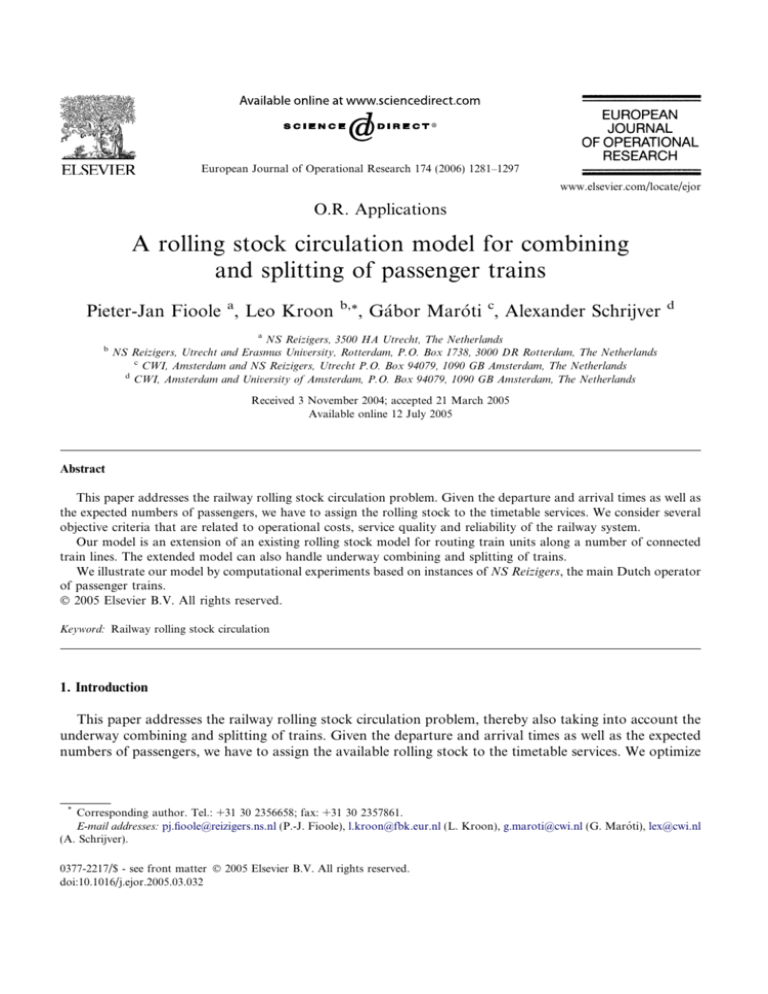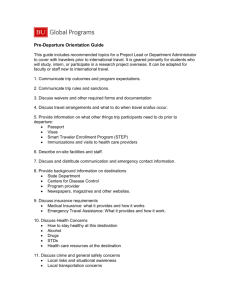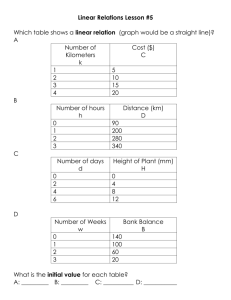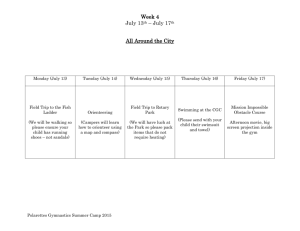
European Journal of Operational Research 174 (2006) 1281–1297
www.elsevier.com/locate/ejor
O.R. Applications
A rolling stock circulation model for combining
and splitting of passenger trains
Pieter-Jan Fioole a, Leo Kroon
b
b,*
, Gábor Maróti c, Alexander Schrijver
d
a
NS Reizigers, 3500 HA Utrecht, The Netherlands
NS Reizigers, Utrecht and Erasmus University, Rotterdam, P.O. Box 1738, 3000 DR Rotterdam, The Netherlands
c
CWI, Amsterdam and NS Reizigers, Utrecht P.O. Box 94079, 1090 GB Amsterdam, The Netherlands
d
CWI, Amsterdam and University of Amsterdam, P.O. Box 94079, 1090 GB Amsterdam, The Netherlands
Received 3 November 2004; accepted 21 March 2005
Available online 12 July 2005
Abstract
This paper addresses the railway rolling stock circulation problem. Given the departure and arrival times as well as
the expected numbers of passengers, we have to assign the rolling stock to the timetable services. We consider several
objective criteria that are related to operational costs, service quality and reliability of the railway system.
Our model is an extension of an existing rolling stock model for routing train units along a number of connected
train lines. The extended model can also handle underway combining and splitting of trains.
We illustrate our model by computational experiments based on instances of NS Reizigers, the main Dutch operator
of passenger trains.
2005 Elsevier B.V. All rights reserved.
Keyword: Railway rolling stock circulation
1. Introduction
This paper addresses the railway rolling stock circulation problem, thereby also taking into account the
underway combining and splitting of trains. Given the departure and arrival times as well as the expected
numbers of passengers, we have to assign the available rolling stock to the timetable services. We optimize
*
Corresponding author. Tel.: +31 30 2356658; fax: +31 30 2357861.
E-mail addresses: pj.fioole@reizigers.ns.nl (P.-J. Fioole), l.kroon@fbk.eur.nl (L. Kroon), g.maroti@cwi.nl (G. Maróti), lex@cwi.nl
(A. Schrijver).
0377-2217/$ - see front matter 2005 Elsevier B.V. All rights reserved.
doi:10.1016/j.ejor.2005.03.032
1282
P.-J. Fioole et al. / European Journal of Operational Research 174 (2006) 1281–1297
different objective criteria that are related to operational costs, service quality and reliability of the railway
system.
The problem we focus on is to determine the rolling stock circulation for a generic week. That is, it arises
in an early phase of the railway planning process. In later stages, this generic plan must be adjusted to the
specific calendar days, and shunting plans must be created. Finally, the traffic control must carry out these
plans, and adapt them in case of disturbances.
A main complicating issue is the fact that the available train units are of different types. This forces one
to keep track of the positions of the different train units within each train. This is particularly important in
the case of combining and splitting trains.
In this paper we give an integer programming model. It deals with an extension of the problem described
by Peeters and Kroon [9]. Their branch-and-price approach strongly uses the fact that trains run up-anddown a number of connected train lines. However, in the case of underway combining and splitting of
trains, this property is lost if several branches of the lines have different lengths, as it happens in real-life
instances of the Dutch passenger railway operator NS Reizigers. The model we are describing here can
be applied for such instances. We used the commercial mixed integer programming software CPLEX to
solve our model.
So far, the rolling stock plans of NS Reizigers were created manually. It turned out that our model is
capable to provide solutions that can be implemented in practice. One of our main achievements is that
the rolling stock circulation for the timetable year 2005 is based on solutions of our model.
This paper is organized as follows. We describe the problem in detail in Section 2. A literature overview
is given in Section 3. In Section 4 we formulate our model. Section 5 contains our computational results.
Finally, in Section 6 some conclusions are drawn.
2. Problem description
2.1. The Noord-Oost case
The train line system that is studied in this paper is the so-called Noord-Oost case, involving the train
lines 500, 700, 1600 and 1700 of NS Reizigers. These train lines form the backbone of the Dutch railway
system, by connecting the cities Amsterdam (Asd), Schiphol (Shl), Rotterdam (Rtd), and The Hague (Gvc)
in the Western part of the Netherlands to the cities Leeuwarden (Lw), Groningen (Gn), and Enschede (Es)
in the Northern and Eastern part of the country. Utrecht (Ut), Amersfoort (Amf), Deventer (Dv), and
Zwolle (Zl) are important underway stations (see Figs. 1 and 2).
The train lines are operated by a given number of self-propelled train units with 3 or 4 carriages each.
Train units can be composed to a longer train in any possible order. The departure and arrival times of the
train services have already been specified in an earlier stage of the planning process. The timetable of the
involved lines is more or less periodic with a period of 1 hour.
An important property of instances at NS Reizigers is that almost every train has a pre-defined successor
is train at its endpoint. A train and its successor train are carried out basically by the same train units. The
short turn-around times of 10–30 minutes allow only very simply structured modifications of the train compositions like adding or uncoupling a train unit at the appropriate side of the train.
The reason for successor trains is that NS Reizigers uses a dense timetable, operating the train lines with
a frequency of 30 or 60 minutes. Therefore the rolling stock cannot stay too long at the stations. Moreover,
the stations have limited shunting capacity due to heavy traffic. Thus in practice, an incoming train is assigned to the first train that departs from the same station.
Another criterion when defining successor trains is to create closed systems of train lines. This means for
example, that the Noord-Oost train lines have as little interaction with other lines as possible. On one hand,
P.-J. Fioole et al. / European Journal of Operational Research 174 (2006) 1281–1297
Lw
1283
Gn
Zl
Shl
Gvc
Asd
Amf
Dv
Es
Ut
Rtd
Fig. 1. The Noord-Oost train lines on the Dutch railway map.
Fig. 2. The Noord-Oost train lines.
rolling stock planning becomes easier, on the other hand, such a planning prevents delays and disturbances
to propagate from one system of lines to another.
Almost all trains in the Noord-Oost are combined or split at certain locations. For example, a train in the
1600 line arriving in Amersfoort from Enschede is split into two parts. The front part continues to Amsterdam, while the rear part continues to Schiphol. On the way back, the train arriving from Schiphol becomes
the front part, it is combined with the train arriving from Amsterdam. Trains in the 1700 line are combined
or split in Utrecht. Trains in the 500 line are combined or split both in Utrecht and in Zwolle, and trains in
the 700 line are combined or split both in Amersfoort and in Zwolle. Note that the timetable specifies from
which stations the front and the rear part of a combined train arrive, and towards which stations the front
and rear part of a split train depart.
Splitting of trains means that a train has two successor trains. We only speak about splitting if the successor trains depart within a couple of minutes after their predecessor train arrived. A similar restriction
applies for combining trains. Thus only very simple composition changes can be carried out when trains
are split or combined.
In the early stage of the rolling stock planning process, very little is known about the shunting possibilities, unless in the case of an incoming train that departs within a couple of minutes. Therefore, we assume
1284
P.-J. Fioole et al. / European Journal of Operational Research 174 (2006) 1281–1297
that the local shunting crew will be able to carry out every composition change when they are given enough
time. The rolling stock plan needs to be adjusted in later stages of the planning process when this assumption leads to unsolvable shunting problems at some stations.
Our task is to assign the train units to the timetable services such that various technical and market constraints are fulfilled. In this study we focus on rolling stock schedules for each day of the week separately. In
Section 4.5, we briefly discuss how solutions for consecutive days can be attached to each other. Computational power is the only limit when considering planning periods longer than one day.
One of the complicating issues in rolling stock management is maintenance of rolling stock units. Maintenance is, however, no requirement in the medium-term rolling stock planning at NS Reizigers. In the
Netherlands, timetables and rolling stock circulations are dense, thus sensitive to disturbances. So, preset
maintenance schedules have little chance to be carried out. Therefore, maintenance is planned in the operational phase, see e.g., Maróti and Kroon [8].
2.2. Objectives
Creating an appropriate rolling stock schedule means finding a balance between several objectives, such
as minimizing: (i) the number of carriage kilometers (efficiency), (ii) the amount of seat shortages (service),
and (iii) the number of shunting movements (robustness). The model described in this paper allows to make
a trade-off between these objectives. The objectives are explained below in detail.
The operational cost of using the rolling stock depends on traction power, but also on maintenance of
the rolling stock: after a certain number of kilometers, each train unit is directed to a maintenance station
for a preventive check-up and repair. In both cases, the number of carriage kilometers is an appropriate
measure for variable rolling stock costs.
The input of our problem contains the estimated number of first and second class passengers for every
timetable service. Good service quality means among others that all passengers, in particular first class passengers, have a seat during their journey. However, during rush hours, there may be more passengers than
seats. Outside rush hours, rolling stock capacity is usually sufficient to provide all passengers with a seat.
Our measure for the seat shortages is the expected number of passengers without a seat multiplied by the
length of the involved trip, and added up for all trips. We call it seat-shortage kilometers.
Train compositions can be modified at certain stations by coupling train units to a train or by uncoupling train units from it. Changing the composition of a train is a complex process. It requires a number
of shunting movements between the platform area and the shunting area of a station. This may lead to disturbances of the regular train operations. Thus a smaller number of shunting operations may increase the
robustness of the railway system. Moreover, the shunting costs are also related to the crew: each shunting
movement requires a train driver. On the other hand, changing the train compositions between two rides
may allow to use the rolling stock more efficiently and also to decrease seat shortages.
3. Literature review
In the literature, several related problems have been studied, apart from the paper by Peeters and Kroon
[9] that was mentioned earlier. These models are often set up for locomotive-hauled railway carriages, and
do not consider the order of the carriages (train units). Moreover, no optimization methods were developed
so far to handle combining and splitting train units.
Schrijver [10] considers the problem of minimizing the number of train units needed to satisfy passengersÕ
seat demand. The model computes for every trip the number of train units of each type to be used, not taking the order of the units in a train composition into account. Seat shortages and the number of shunting
movements are not considered.
P.-J. Fioole et al. / European Journal of Operational Research 174 (2006) 1281–1297
1285
Alfieri et al. [2] describe an integer programming model to determine the circulation of rolling stock
(including the order of the train units in the compositions) on a single train line and a single day. The objective is to minimize the number of train units needed to satisfy the demand; seat shortages and the number of
shunting operations are not taken into account. Their approach was tested on real-life case-studies of NS
Reizigers.
Brucker et al. [4] study the problem of routing single railway carriages through a network: The carriages
should be used in timetable services or empty trains such that each timetable service can be operated with a
given number of carriages. The order of the carriages is not considered. Their solution approach is based on
local search techniques like simulated annealing.
Ben-Khedher et al. [3] study the problem of allocating identical train units to the French High Speed
Trains. Their rolling stock allocation system is based on a capacity adjustment model that is linked to
the seat reservation system and seeks to maximize the expected profit for the company.
Cordeau et al. [5] present a Benders decomposition approach for the locomotive and carriage assignment
problem. Computational experiments show that optimal solutions can be found quickly. In a subsequent
paper, Cordeau et al. [6] extend their model with various real-life constraints, such as maintenance. Neither
of these models considers the order of the carriages in the train compositions in detail.
Lingaya et al. [7] describe a model for operational management of locomotive-hauled railway carriages.
They explicitly take the order of the carriages in the trains into account. Several real-life constraints, such as
maintenance, are considered. The solution approach is based on a Dantzig-Wolfe reformulation solved by
column generation.
Abbink et al. [1] present an integer programming model for distributing the available rolling stock between the train lines. This model does not determine an actual schedule. Instead, seat shortages during the
morning rush hours are minimized by allocating rolling stock to the trains running at 8 oÕclock in the morning, the busiest moment of the day. This model can provide the number of available train units when the
rolling stock scheduling problem is solved for each train line separately.
4. Model formulation
In this section we first describe the model without combining and splitting trains. However, it is possible
to modify a train composition by coupling or uncoupling train units before the train departs from its origin
station, underway, and after the train arrives at its endpoint. Thereafter we extend the basic model in Section 4.4 with combining and splitting of trains.
In our model, we assume that train units stored at a station can be coupled later to any of the departing
trains from that station, irrespective of the arrival order of the stored train units. This explains the difference between splitting and uncoupling: In case of splitting, the split parts serve in passenger trains. In particular, the order of the train units in the split parts does matter. However, uncoupled train units are
transferred to the shunting area at the station, and there the order of the train units does not matter anymore. The re-allocation time described below reserves time for shunting. The difference between combining
and coupling is similar.
4.1. The model without combining and splitting
The set of stations is denoted by S. Let M be the set of train unit types. In the Noord-Oost case, we have
two types: units with 3 or 4 carriages. For each m 2 M, let nm denote the number of available train units of
type m.
A composition of train units is an ordered sequence of elements of M. For example, the strings Ô334Õ and
Ô343Õ represent possible compositions containing two train units of length 3 and one train unit of length 4.
1286
P.-J. Fioole et al. / European Journal of Operational Research 174 (2006) 1281–1297
When assigning compositions to train rides, we assume that the left-hand side of the string corresponds to
the front of the train.
The order of the units in a train composition plays an important role. Train compositions Ô334Õ and Ô343Õ
have the same capacity, but they differ in shunting possibilities. The train unit with 4 carriages can be
uncoupled much more easily from composition Ô334Õ than from composition Ô343Õ. Let nm,p denote the number of train units of type m in composition p. For a composition p, let bðpÞ 2 ZM be such that b(p)m = np,m
for each train unit type m 2 M.
A trip is a sequence of consecutive train movements during which the train composition cannot change.
Let T be the set of trips. A trip t is characterized by its departure station sd (t), arrival station sa (t), departure time sd (t) and arrival time sa (t).
The set of compositions that are allowed for trip t is denoted by Pt. When determining the sets Pt, the
following aspects are taken into account: (i) the capacity of the train should be sufficient to provide a certain service level, and (ii) the length of the train may not exceed a certain upper bound, mainly determined
by the lengths of the platforms along the trip.
Let m(t) denote the successor trip of trip t: the train that carries out trip t carries out trip m(t) immediately
after t, although some units may be (un)coupled. The set T0 denotes the set of trips that have no defined
previous trip, while T1 denotes the set of trips without defined successor trip. We assume that for a trip
t 2 T0, all train units serving t must be coupled just before t, while for a trip t 2 T1, all train units must
be uncoupled just after t.
Let Ct denote the set of pairs of compositions (p, p 0 ) such that p 2 Pt, p 0 2 Pm(t), and such that the composition change p ! p 0 after trip t is allowed. Thus the shunting possibilities are encoded in the sets Ct.
In instances of NS Reizigers, a general constraint is that either some units may be uncoupled or some
units may be coupled but not both. Coupling and uncoupling train units is only allowed at the front or rear
side of a train composition, depending on the infrastructure of the station. For example, the train unit of
length 4 cannot be uncoupled from a composition Ô343Õ. On the other hand, if the station allows shunting at
the rear side of the train, then a composition change from Ô334Õ to Ô33Õ is possible.
In practice, a train unit, that has been uncoupled from a train, cannot be coupled immediately onto another train: a certain re-allocation time .(s), depending on the station, has to be respected. We model this as
follows. Train units that are stored temporarily at a station can be coupled to a departing train immediately. However, an uncoupled train unit appears at the station as an available train unit only .(s) minutes
later. We illustrate this schematically in Fig. 3. The station s is represented by a time-line, and we consider a
pair of arrival and departure events. (Un)coupled units go through the arcs that connect the time-line to the
arrival or departure event nodes.
The main decision variables in the model are the following:
Xt,p 2 {0,1} whether composition p is used for trip t,
Zt,p,p 0 2 {0,1} whether trip t has composition p and trip m(t) has composition p 0 .
Fig. 3. Coupling and uncoupling train units.
P.-J. Fioole et al. / European Journal of Operational Research 174 (2006) 1281–1297
1287
The variable Nt,m denotes the number of train units of type m that are used on trip t. We also introduce
the variables Ct,m and Ut,m: Ct,m expresses the number of train units of type m that have been coupled to the
train composition right before trip t, and Ut,m expresses the number of train units of type m that have been
uncoupled from the train composition right after trip t.
The variable It,m denotes the number of train units of type m that are stored (i.e., available for being
coupled to a train) at station sd(t), immediately after the departure of trip t. Note that this inventory value
might not be equal to the number of train units that are physically present at the station: Train units that
are used both for trip t and m(t) are not considered to be stored between the arrival of trip t and the departure of trip m(t). Moreover, uncoupled train units increase the local inventory only after the re-allocation
time has elapsed, while coupled units decrease it immediately.
The variable I 0s;m denotes the number of train units of type m that start the day at station s. Now the basic
part of the model reads as follows:
min
subject to
F ðX ; Z; N Þ
X
X t;p ¼ 1
p2P t
ð1Þ
8t 2 T ;
X
X t;p ¼
ð2Þ
Z t;p;p0
8t 2 T n T 1 ; p 2 P t ;
ð3Þ
Z t;p;p0
8t 2 T n T 1 ; p0 2 P mðtÞ ;
ð4Þ
p0 2P mðtÞ :ðp;p0 Þ2Ct
X
X mðtÞ;p0 ¼
p2P t :ðp;p0 Þ2Ct
N t;m ¼
X
p2P t
C mðtÞ;m ¼
np;m X t;p
X
8t 2 T ; m 2 M;
ðnp0 ;m np;m Þ Z t;p;p0
ð5Þ
8t 2 T n T 1 ; m 2 M;
ð6Þ
ðp;p0 Þ2Ct :
np0 ;m >np;m
U t;m ¼
X
ðnp;m np0 ;m Þ Z t;p;p0
8t 2 T n T 1 ; m 2 M;
ð7Þ
ðp;p0 Þ2Ct :
np;m >np0 ;m
C t;m ¼ N t;m and U t;m ¼ 0
8t 2 T 0 ; m 2 M;
ð8Þ
U t;m ¼ N t;m and C t;m ¼ 0
X
I 0s;m ¼ nm 8m 2 M
8t 2 T 1 ; m 2 M;
ð9Þ
s2S
I t;m ¼ I 0sðtÞ;m X
ð10Þ
t0 2T :sd ðt0 Þ¼sd ðtÞ;
sd ðt0 Þ6sd ðtÞ
X t;p 2 f0; 1g
2 Zþ
Z t;p;p0 2 Rþ
U t0 ;m
8t 2 T ; m 2 M;
ð11Þ
t0 2T :sa ðt0 Þ¼sd ðtÞ;
sa ðt0 Þ6sd ðtÞ.ðsd ðtÞÞ
8t 2 T ; p 2 P t
N t;m ; C t;m ; U t;m ; I t;m 2 Rþ
I 0s;m
X
C t0 ;m þ
8t 2 T ; m 2 M;
8s 2 S; m 2 M;
0
8t 2 T ; ðp; p Þ 2 Ct .
ð12Þ
ð13Þ
ð14Þ
ð15Þ
We describe the objective function (1) in detail in Section 4.2. Constraints (2) state that, for each trip, exactly one allowed composition of train units is to be used. Constraints (3) and (4) guarantee a correct link
between the compositions that are used for consecutive trips. Constraints (5) describe the connection between the composition that is used for a certain trip and the numbers of train units of the different types
1288
P.-J. Fioole et al. / European Journal of Operational Research 174 (2006) 1281–1297
that are used on this trip. Constraints (6)–(9) specify the number of coupled and uncoupled train units.
Constraints (10) handle the correct allocation of the available train units to the initial inventories at the
different stations. Constraints (11) describe the inventory of train units in the different stations. To compute
the value It,m, we consider the number of train units that are stored at the station at the begin of the day,
then we increase or decrease it whenever a train unit was uncoupled or coupled until the departure time of
trip t. Finally, constraints (12)–(15) describe the binary or non-negative character of the variables.
One easily verifies the following lemma.
Lemma 1. In any feasible solution to the model (1)–(15), the variables Ut,m, Ct,m, It,m and Zt,p,p 0 are integral.
Proof. The variables Ut,m, Ct,m, It,m and Zt,p,p 0 are uniquely determined by the integer variables Xp,m and
I 0s;m . h
Note that the composition changes could be modelled without the variables Zt,p,p 0 but using additional
linear constraints on the variables Xt,p. Such a model is described by Alfieri et al. [2]. However, one easily
proves that the linear relaxation of their model defines a polytope that strictly contains the linear relaxation
of our model. Therefore the branch and bound procedure in our model works with better lower bounds.
Moreover, according to Lemma 1, we never have to branch on a variable Zt,p,p 0 . Thus we can expect that
the number of nodes in the branch and bound tree becomes smaller. On the other hand, we have to solve
larger linear programs. State-of-the-art software such as CPLEX can, however, cope with linear programs
that appear in our applications. The model described above can be solved to (near) optimality for instances
of NS Reizigers that were computationally intractable by earlier models.
4.2. Objective function
As was mentioned earlier, the objective function contains three major elements: (i) carriage kilometers,
(ii) seat-shortage kilometers, and (iii) the number of shunting movements. Given the above defined decision
variables, these elements can be computed easily.
For the total number of carriage kilometers CKM, the following holds:
XX
CKM ¼
‘t cm N t;m ;
ð16Þ
t2T m2M
where ‘t is the length of trip t and cm is the number of carriages in a train unit of type m.
The total number of seat-shortage kilometers SKM can be determined as follows:
XX
‘t st;p X t;p .
SKM ¼
t2T
ð17Þ
p2P t
Here, st,p denotes the expected number of seat shortages when composition p is used for trip t. The shortage
is computed by comparing the forecasted number of passengers to the capacity of the train compositions.
Coupling and uncoupling at the same time is not allowed for a composition change from p to p 0 . Therefore the total number of shunting movements SHM can be determined by adding all the variables Z t;p;p0 with
bðpÞ 6¼ bðp0 Þ. Thus
X X
SHM ¼
Z t;p;p0 .
ð18Þ
t2T
ðp;p0 Þ2Ct :
bðpÞ6¼bðp0 Þ
We minimize a non-negative linear combination of these criteria, the weight factors reflecting their relative importance. In order to guide the different elements of the objective function more explicitly, we also
introduce upper bounds on CKM, SKM and SHM.
P.-J. Fioole et al. / European Journal of Operational Research 174 (2006) 1281–1297
1289
Note that the quality of the solutions can be measured by several other characteristics. For example, the
largest seat shortage on a trip should not be too high (e.g., 20% of the passengers of a trip during rush
hours). Seat shortages in the first class can be penalized more heavily than in the second class. Another criterion is to keep the number of shunting movements during rush hours small. The objective function and
the constraints can easily be modified in order to take these additional criteria into account.
4.3. New integer decision variables
The variables Xt,p describe the exact train composition for each trip t. Now it turns out that, if new binary
decision variables are introduced to describe the length of a train, then the integrality constraint for the variables Xt,p can be dropped. By this reformulation, the number of binary decision variables becomes smaller: in
the Noord-Oost case, about 9900 binary variables Xt,p are replaced by about 5700 new binary variables.
The new decision variables determine the number of train units per type that is allocated for the trips,
without specifying the exact order in the train. For a trip t, we define the set of vectors in ZM
þ
Bt ¼ fbðpÞjp 2 P t g.
Recall that b(p) describes the numbers of train units of the different types in composition p, which basically
imply the corresponding train lengths. Thus the set Bt contains the possible train lengths for trip t. Next, we
introduce the binary variables
Yt,b 2 {0, 1} indicating whether combination b 2 Bt is used for trip t.
Their connection with the already defined variables Xt,p is described by
X
X t;p 8t 2 T ; b 2 Bt .
ð19Þ
Y t;b ¼
p2P t :b¼bðpÞ
The variables Yt,b correspond to the higher-level decisions like capacity allocation, while the variables Xt,p
fill in the fine details of the solution.
Theorem 2. Consider the model (1)–(15) extended by the binary variables Yt,b and by the constraints (19).
Replace the constraint (12) in this model by 0 6 Xt,p 6 1 "t 2 T; pt 2 Pt. Then this relaxed mixed integer
program has an integral optimal solution whenever it has a feasible solution.
Proof. Let ðX ; Y ; N ; C; U ; I 0 ; I; ZÞ be an optimal solution to the relaxed problem: the variables Y t;b are binary, while the variables X t;p may have fractional values. Consider the directed graph with node set
fðt; pÞ : t 2 T ; p 2 P t g and arc set fððt; pÞ; ðmðtÞ; p0 ÞÞ : t 2 T T 1 ; ðp; p0 Þ 2 Ct g. Set the capacity of an arc
to 0 if the corresponding value Z t;p;p0 is zero, and set the capacity to 1 otherwise. The values Z t;p;p0 form a
b t;p;p0 with the same amount
network flow in this graph. Thus there exists an integer valued network flow Z
b
of flow. Define the values X t;p according to the constraints (3) and (4).
We shall prove that the variables Yt,b and I 0t;m uniquely determine the variables Ct,m, Ut,m and It,m as well
b ; Y ; N ; C; U ; I 0 ; I; Z
b Þ is an
as the objective criteria CKM, SKM and SHM. Then it is easy to verify that ð X
integral feasible (and optimal) solution to the relaxed model.
P
One easily derives that for each trip t and train unit type m, we have N t;m ¼ b2Bt bm Y t;b . Consider now
any trip t. The integrality of the variables Yt,b implies that a variable Xt,p can have a positive value only if
the composition p contains as many units of each type as the variables Nt,m indicate. Then (3) and (4) imply
that all members of the set fðp; p0 Þ 2 Ct j Z t;p;p0 > 0g have the same differences nm;p0 nm;p for every m 2 M
(namely N mðtÞ;m N t;m ). Therefore C t;m ¼ maxfN mðtÞ;m N t;m ; 0g and U t;m ¼ maxfN t;m N mðtÞ;m ; 0g. It
follows that the variables I t;m are also uniquely determined.
Clearly, the number of carriage kilometers CKM only depends on the variables Yt,b. Moreover, the
number of seat-shortage kilometers SKM is also determined by the variables Yt,b. Indeed, all compositions
1290
P.-J. Fioole et al. / European Journal of Operational Research 174 (2006) 1281–1297
that correspond to a certain combination b 2 Bt have the same capacity and thus the same amount of seat
shortages (denoted by st,b) on trip t. Therefore
XX
‘t st;b Y t;b .
SKM ¼
t2T
b2Bt
P
Finally, each trip has a contribution bðpÞ6¼bðp0 Þ Z t;p;p0 to the number of shunting movements
P SHM. This
contribution is 1 if Nt,m5Nm(t),m for some train unit type m, and 0 otherwise. Since N t;m ¼ b2Bt bm Y t;b , the
number of shunting movements SHM is determined by the variables Yt,m. h
4.4. Combining and Splitting
In order to handle combining and splitting trains, we use an extension of the basic model. Here we only
describe splitting trains. Combining two trains can be described in a similar way.
Let Ts be the set of trips after which the corresponding train is split into two trains. Then for each trip
t 2 Ts, there are two trips m1(t) and m2(t) that take place immediately after splitting trip t. Recall that the
departure order of the trips m1(t) and m2(t) is determined by the timetable.
Let Cst be the set of 3-tuples ðp; p1 ; p2 Þ such that p1 2 P m1 ðtÞ , p2 2 P m2 ðtÞ , p 2 P t , and p is the concatenation of
the strings p1 and p2 . We introduce a variable Z st;p;p1 ;p2 2 ½0; 1 for each t 2 T s and ðp; p1 ; p2 Þ 2 Cst . These variables are linked to the other variables similarly to constraints (3) and (4):
X
Z st;p;p1 ;p2 8p 2 P t ;
ð20Þ
X t;p ¼
p1 ;p2 :ðp;p1 ;p2 Þ2Cst
X m1 ðtÞ;p1 ¼
X
p;p2 :ðp;p1 ;p2 Þ2Cst
X m2 ðtÞ;p2 ¼
X
p;p1 :ðp;p1 ;p2 Þ2Cst
Z st;p;p1 ;p2
8p1 2 P m1 ðtÞ ;
ð21Þ
Z st;p;p1 ;p2
8p2 2 P m2 ðtÞ .
ð22Þ
It is possible to modify the compositions further by allowing to couple or uncouple units when the train
is split. This can easily be modelled by modifying the sets Cst . The variables Ct,m and Ut,m as well as the
objective function should then also be adjusted by requiring constraints similar to (6) and (7).
Then Lemma 1 extends to the following lemma.
Lemma 3. In any feasible solution to the model (1)–(15), (20)–(22), the variables Ut,m, Ct,m, Is,t, Zt,p,p 0 and
Z st;p;p1 ;p2 have integral values.
In the case of combining and splitting, we can introduce the decision variables Yt,b described in Section
4.3. Unfortunately, Theorem 2 does not extend: Easy (but artificial) examples show that introducing the
variables Yt,b and relaxing the variables Xt,p may lead to a feasible model which does not have any feasible
integral solution. However, when we tested the model with relaxed integrality of the variables Xt,p on practical instances, we always found fully integral optimal solutions. Nevertheless, in our computations we declared both variables Yt,b and Xt,p to be integral with different branching priorities (see Section 5.1).
4.5. Further constraints
Our model can be adjusted in order to incorporate further practical requirements as follows.
When creating schedules for every day of the week separately, we should make sure that the solutions for
separate days can be attached to each other. One possibility is to create cyclic solutions: at every station, the
inventory values at the beginning of the day are equal to the inventory values at the end of the day. Then a
P.-J. Fioole et al. / European Journal of Operational Research 174 (2006) 1281–1297
1291
cyclic solution can be applied repeatedly. The final inventory value of train unit type m at station s can be
expressed as follows:
X
X
0
C t;m þ
U t;m .
ð23Þ
I1
s;m ¼ I s;m t2T :
sd ðtÞ¼s
t2T :
sa ðtÞ¼s
Then the cyclicity constraint amounts to
I 0s;m ¼ I 1
s;m
8s 2 S; m 2 M.
ð24Þ
A reason to handle so is that the generic Tuesday, Wednesday and Thursday timetables are nearly identical
and that the expected numbers of passengers on these days are also very similar. We note that in practical
instances for other days of the week such cyclicity constraints are usually replaced by constraints that
explicitly prescribe the inventory values of the different train unit types at the beginning and at the end
of the day.
Stations may have a bounded storage capacity. This can be expressed by imposing upper bounds on the
inventory variables It,m. Note that in this case, the integrality constraint of the initial inventory variables I 0s;m
can be relaxed without decreasing the objective function value. More realistically, we can give bounds on
the number of carriages that are stored after the departure of trip t:
X
cm I t;m 6 B;
ð25Þ
m2M
where cm denotes the number of carriages in train type m.
The continuity requirement states that for each timetable service (which is represented as a sequence of
trips with the same train number), at least one train unit should follow the complete route of that service.
As a consequence, a passenger can travel along the complete route of the timetable service without changing seats underway.
In the case of the Noord-Oost lines, timetable services have one (un)coupling possibility on their way.
This makes that the continuity requirement is easy to formulate in terms of already declared variables.
For example, consider the 1600 line in Fig. 2. Train units departing from Amsterdam (Asd) and Schiphol
(Shl) are combined in Amersfoort and they go together to Enschede (Es). The front part of the combined
train arrived from Schiphol, while the rear part arrived from Amsterdam. Coupling or uncoupling is only
possible in Deventer (Dv): adding units to the front of the train, or removing units from the rear. Then the
continuity constraint for one train between Asd–Es and Shl–Es amounts to
X
X
U AmfDv;m 6
N AsdAmf;m 1.
ð26Þ
m2M
m2M
In this way we make sure that the number of train units uncoupled in Dv is less than the number of train
units in the train Asd–Amf. Moreover, none of the train units that arrived from Shl can be uncoupled (as
being at the front of the train), thus the direct connection Shl–Es is always provided.
4.6. Special structure of the instances
We can exploit the special structure of the instances as follows. If a train after trip t1 is split in Utrecht
(Ut), one part goes to The Hague (Gvc) (trip t2), the other part goes to Rotterdam (Rtd) (trip t3). These
parts turn back to Utrecht (trips t4 and t5) immediately where they are combined again and leave Utrecht
(trip t6) together. When a train is split or combined in Utrecht, no train units can be coupled or uncoupled.
Coupling and uncoupling is allowed in Rotterdam and The Hague (see Fig. 4).
1292
P.-J. Fioole et al. / European Journal of Operational Research 174 (2006) 1281–1297
Fig. 4. Splitting and combining in Utrecht.
We define binary decision variables Z Ut
t1 ;p1 ;p2 ;p3 ;p4 ;p5 ;p6 having value 1, if for each i = 1, . . . , 6, trip ti has composition pi. We delete from our model all the variables Xt,p, Yt,p and Z t;p;p0 that are attached to the trips t2, t3,
t4 and t5. We also delete the variables Zs (and Zc) we used to describe splitting (and combining) at trips t1
(and t6). Instead, we introduce constraints that are similar to constraints (3) and (4)
X
X t1 ;p ¼
Z Ut
8p 2 P t1 ;
t1 ;p;p2 ;p3 ;p4 ;p5 ;p6
p2 ;...;p6
X t6 ;p ¼
X
Z Ut
t1 ;p1 ;p2 ;p3 ;p4 ;p5 ;p
8p 2 P t6 .
p1 ;...;p5
In order to keep track of the number of (un)coupled units in Rotterdam and The Hague, we use integer
variables U t2 ;m , U t3 ;m , C t4 ;m , and C t5 ;m , and express them as weighted sums of the variables ZUt similarly
to (6) and (7). The variables ZUt appear in the objective function with weights that indicate the carriage
kilometers, seat-shortage kilometers and the number of shunting movements for the deleted trips t2, . . . , t5.
Finally, we introduce the binary variables DGvc (and DRtd) that express whether or not a composition
change happens between trips t2 t4 (and between trips t3 t5). These variables can also be written as
sums of the variables ZUt.
This aggregation leads to a model with a higher number of decision variables, since the number of possible 6-tuples (p1, . . . , p6) is large, over 700 in our case. However, we eliminated a number of auxiliary variables Zt,p,p 0 , Zs, and Zc attached to the trips t2, . . . , t5, and also all binary decision variables describing the
compositions on these trips.
Moreover, one can derive from the shunting constraints in the Noord-Oost case that if we relax the integrality constraint of the variables ZUt, then appropriate rounding on these variables immediately leads to a
feasible integral solution. (Note that during our computations, we needed such rounding very rarely: once
among about 100 instances.) Although the solution obtained in this way may not be optimal among all integral solutions, the difference in the objective function is very small. Therefore we declare the new variables
ZUt binary with lowest branching priority: we can expect that with this priority setting, a branch and bound
algorithm finds integral suboptimal solutions faster. We analyze the effect of this aggregation on the solution time in Section 5.1.
5. Computational results
We implemented the model described in the previous sections for the Noord-Oost lines for one day. This
line system contains 167 timetable services, we divided them into 665 trips, according to the possibilities to
change the compositions underway. The Noord-Oost lines are operated by about 50 train units of length 3
and 35 train units of length 4. The maximal allowed length of a train is 8–15 carriages on the different trajectories. As it turned out, the manually created rolling stock plan as well as our solutions allocate about 6.8
carriages (2.0 train units) on average for a task.
P.-J. Fioole et al. / European Journal of Operational Research 174 (2006) 1281–1297
1293
Table 1
Objective criteria in the practical solution and our weight factors
Value in practice
CKM
317,853
SKM
555,215
SHM
135
Weight
Weight
Weight
Weight
Weight
1
1
1
1
1
1
1
1
10
10
5000
1000
100
1000
100
in
in
in
in
in
Obj1
Obj2
Obj3
Obj4
Obj5
Table 2
Dimensions of the MIPÕs: number of variables (integer and continuous), constraints and non-zeros in the matrix
Without aggregation
#
#
#
#
#
Integer variables
Continuous variables
Variables
Constraints
Non-zeros
With aggregation
MIP
Reduced MIP
MIP
Reduced MIP
17,776
33,901
51,677
32,308
195,184
–
–
34,228
17,896
136,105
32,197
24,560
56,757
28,149
287,286
–
–
39,251
15,348
177,622
For our computations we used the modelling software ILOG OPL Studio 3.7 and the mixed integer programming solver ILOG CPLEX 9.0 on a PC with an Intel Pentium IV 3.0 GHz processor and with 512 MB
internal memory. Our goal was to find feasible solutions of good quality in reasonable time. If necessary, we
stopped our computations after a couple of hours of CPU time.
We compared our solutions to a manually created rolling stock plan. In Table 1 we give the values of the
three objective criteria in this reference solution. We made experiments with several objective functions. The
weight factors for carriage kilometers (CKM), seat-shortage kilometers (SKM) and the number of shunting
operations (SHM) are also given in Table 1. According to the preferences of NS Reizigers, we gave a relatively low weight factor to CKM in the objective function but required the constraint
CKM 6 318; 000.
Moreover, in some experiments we looked for solutions with CKM as small as possible while still providing
significantly better service than the reference solution does.
The first two columns of Table 2 (under ÔWithout aggregationÕ) contain the dimensions of the mixed integer program as well as the size of the reduced MIP, created by CPLEX in the preprocessing phase.
5.1. Speeding-up the solution process
Finding feasible solutions of good quality turned out to be quite time-consuming. In order to speed up
the solution process, we applied various techniques.
Fine-tuning the parameters of CPLEX had a large impact on the solution times. We used the barrier
method to solve the root node of the branch and bound tree. Then we applied the dual simplex method
for any other node. Using the built-in heuristics frequently, applying probing, perturbing the objective function, and using branching priorities (explained below) turned out to be particularly helpful.
5.1.1. Using priorities when branching
The variables in our model have a hierarchical structure. The variables Nt,m describe the number of train
units of a given type m used for trip t. The variables Yt,b represent decisions one level lower, while the
1294
P.-J. Fioole et al. / European Journal of Operational Research 174 (2006) 1281–1297
variables Xt,p specify the finer details. As we observed, the objective criteria are basically functions of the
variables Yt,b.
It turned out to be advantageous to branch first on the variables Nt,m, then on the variables Yt,b, and at
last on the variables Xt,p. (We declared the variables Nt,m integral.) This can be explained as follows. The
values Nt,m describe a rough estimate of the solution. Nevertheless, early decisions on train lengths determine a large part of the objective function. Therefore, the branch and bound process can work out the exact
train compositions subject to good lower bounds. We mentioned in Section 4.4 that, once the Yt,b variables
are integral, the Xt,p variables are likely integral, too.
Giving a higher branching priority to the decision variables corresponding to trains in the rush hours
also led to an improvement of the solution time. Seat shortages mostly occur in such trains, thus very good
lower bounds on the seat shortages can be computed in the early stage of the algorithm. Then the rolling
stock assignment for the rush hours extends to the rest of the day, providing good suboptimal solutions
relatively quickly.
5.1.2. Exploiting the structure of the instances
When applying the aggregation described in Section 4.6, the mixed integer program contains more variables but less constraints. The dimensions of the mixed integer program is given in the two last columns of
Table 2 (under ÔWith aggregationÕ). We noted in Section 4.6 that the vast majority of the 16,565 variables
ZUt are almost always integral, they have the lowest branching priority. This means that the mixed integer
program has only 15,724 ‘‘essential’’ integer variables which is smaller than in the model without
aggregation.
The linear programming relaxation with aggregation provides slightly better bounds than in the case of
no aggregation. Although the difference turned out to be small, about 0.1–0.9% of the optimal objective
value, even this improvement resulted in speeding up the solution process. The effect of using the aggregation is presented in Table 3. In three test instances, we imposed the constraint CKM 6 318,000, and
different bounds, if any, on SHM. We tested all instances with and without aggregation, minimizing the
five objective functions in Table 1. In each row, we give the optimality gap proved in 2 hours of computation, and after how many seconds the best solution was found. A field without numbers means that no
feasible solution was found within 2 hours. For these instances, we applied the heuristic approach in
Table 3
For each test instance: (i) optimality gap after 7200 seconds, (ii) time elapsed till the best solution was found (in seconds)
CKM
SHM
Aggregation
Obj1
Obj2
Obj3
Obj4
Obj5
318,000
–
Yes
1.69%
3000
0.22%
3200
opt
2000
opt
1900
opt
2700
318,000
–
No
2.56%
5400
0.76%
5000
opt
5000
0.12%
4300
opt
4400
318,000
120
Yes
2.30%
3500
0.50%
7100
1.24%
3400
2.22%
6500
2.32%
5100
318,000
120
No
2.06%
4800
0.67%
6400
–
–
11.20%
6300
13.16%
5000
318,000
90
Yes
4.80%
6000
2.67%
7100
–
–
11.43%
6400
–
–
318,000
90
No
4.90%
5700
16.11%
5300
–
–
–
–
–
–
P.-J. Fioole et al. / European Journal of Operational Research 174 (2006) 1281–1297
1295
Section 5.2. We can see that the aggregation significantly improves the performance of the branch and
bound process.
5.2. Heuristic approaches
Comparing the objective value of the linear relaxation to the best lower bound proved during the branch
and bound process, the difference turned out to be small, at most 2%. Solutions with small optimality gap
indicate that our model is a quite tight description of the convex hull of the integral solutions. This justifies
the following heuristic method.
5.2.1. Search around the LP optimum
For some instances, depending on the objective function and on the bounds of the objective criteria, no
feasible solution could be found in 2 hours of computation or the quality of the solutions was not satisfactory. In these cases, we applied the following method.
We first solved a relaxation of the problem, dropping the integrality requirements for some variables
(e.g., taking the linear relaxation itself). Then we extracted information from the optimal (fractional) solution to the relaxation, and based on it, we added extra constraints to the original model. In the simplest
form, we required Xt,p = 0 whenever this variable had value zero in the optimal solution to the relaxed
model. As another example, we allowed a composition change (that is, extra shunting) after trip t only
if the optimal solution to the relaxation had a variable Z t;p;p0 > 0 with bðpÞ 6¼ bðp0 Þ.
Reducing the solution space in this way allowed us to find feasible solutions within 2 hours for each instance. The optimality gap was, however, still over 10% in some instances. Nevertheless, even these solutions were in all objective criteria better than the reference solution from practice.
5.2.2. Local search
Once a feasible solution r was found, we ran our model in some ‘‘neighborhood’’ of this solution. We
defined the neighborhood by constraints like saying that for each trip, the composition may be at most one
carriage shorter or longer than in r. In case of smaller neighborhoods, the reduced solution space could be
enumerated relatively quickly, but often they did not lead to any improvement. For larger neighborhoods
we allowed running times up to 4 hours. After a few local search steps, we were able to find feasible solutions with optimality gaps of 2–5%.
We applied this local search to minimize only the carriage kilometers while imposing upper bounds on
seat-shortages per trip, and on the number of shunting movements. We found solutions with as few as
297,000–303,000 carriage kilometers. Compared to 318,000 carriage kilometers in the reference solution,
it amounts to a reduction in operational costs by nearly 6%.
5.3. Comparison to the reference solution
In this section we compare the values of the objective criteria in our solutions to those in the manually
created reference solution. Fig. 5 shows all rolling stock schedules we created where the number of carriage
kilometers is not higher than in the reference solution. The x-axis represents the seat-shortage kilometers,
the y-axis represents the numbers of shunting operations. We drew a small circle with appropriate x and y
coordinates for solutions we found. The curved line indicates the linear programming lower bound. Solutions that lie far away from this line or that are dominated by other solutions were obtained by emphasizing
additional optimization criteria: by penalizing first class seat-shortages and shunting during rush hours
more heavily.
1296
P.-J. Fioole et al. / European Journal of Operational Research 174 (2006) 1281–1297
Fig. 5. Shortage kilometers and number of shunting operations in the solutions with at most 318,000 carriage kilometers.
As mentioned earlier, all the solutions in Fig. 5 obey the constraint CKM 6 318,000. The solutions inside the dashed circle in Fig. 5 have only 297,000–303,000 carriage kilometers.
6. Conclusions
In this paper, we described a model for the weekly rolling stock planning. Our model can express various
technical and market requirements. We tested the model on fairly large instances of the Dutch passenger
railway operator NS Reizigers. Our model turned out to be robust enough to cope with very different
weights on the objective criteria. When solved by a commercial MIP solver, it provided rolling stock schedules with different objective characteristics in a couple of hours of computation time. The decision makers
can choose a solution that matches the practical requirements best. The planners at NS Reizigers
agreed that the solutions to our model are in any respect better than the manually created plans. Starting
with the timetable year 2005, the weekly rolling stock schedule of NS Reizigers is partly computed by this
model.
Acknowledgement
This research was supported by the Human Potential Programme of the European Union under contract
no. HPRN-CT-1999-00104 (AMORE).
References
[1] E.J.W. Abbink, B.W.V. van den Berg, L.G. Kroon, M. Salomon, Allocation of railway rolling stock for passenger trains,
Transportation Science 38 (1) (2004) 33–42.
[2] A. Alfieri, R. Groot, L.G. Kroon, A. Schrijver, Efficient Circulation of Railway Rolling Stock, ERIM Research Report, ERS2002-110-LIS. Erasmus University Rotterdam, The Netherlands, submitted for publication.
[3] N. Ben-Khedher, J. Kintanar, C. Queille, W. Stripling, Schedule optimization at SNCF: From conception to day of departure,
Interfaces 28 (1998) 6–23.
[4] P. Brucker, J. Hurink, T. Rolfes, Routing of railway carriages: A case study, Osnabrücker Schriften zur Mathematik, Reihe P,
Heft 205 (1998).
[5] J.F. Cordeau, F. Soumis, J. Desrosiers, A benders decomposition approach for the locomotive and car assignment problem,
Transportation Science 34 (2000) 133–149.
[6] J.F. Cordeau, F. Soumis, J. Desrosiers, Simultaneous assignment of locomotives and cars to passenger trains, Operations
Research 49 (2001) 531–548.
P.-J. Fioole et al. / European Journal of Operational Research 174 (2006) 1281–1297
1297
[7] N. Lingaya, J.F. Cordeau, G. Desaulniers, J. Desrosiers, F. Soumis, Operational car assignment at VIA rail Canada,
Transportation Research B 36 (2002) 755–778.
[8] G. Maróti, L.G. Kroon, Maintenance routing for train units: The transition model, CWI Research Report PNA-E0415,
Amsterdam, 2004.
[9] M. Peeters, L.G. Kroon, Circulation of railway rolling stock: A branch-and-price approach, ERIM Research Report, ERS-2003055-LIS. Erasmus University Rotterdam, The Netherlands (submitted for publication).
[10] A. Schrijver, Minimum circulation of railway stock, CWI Quarterly 6 (1993) 205–217.








